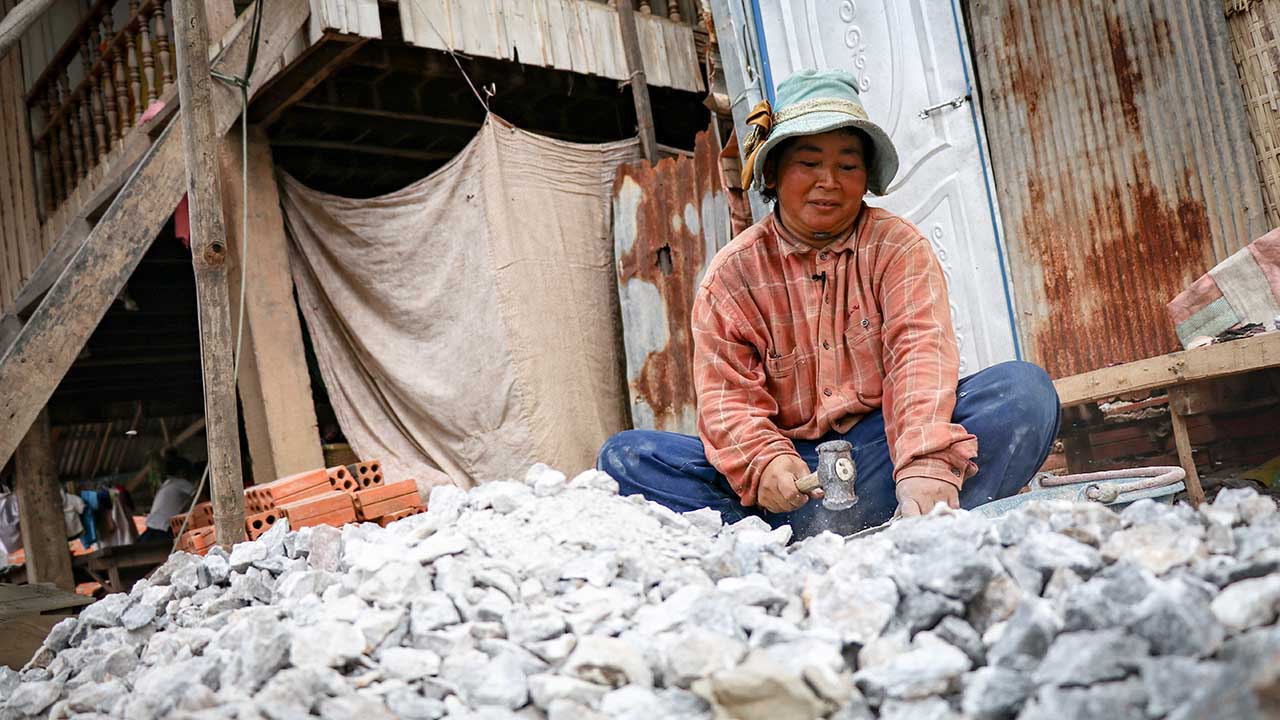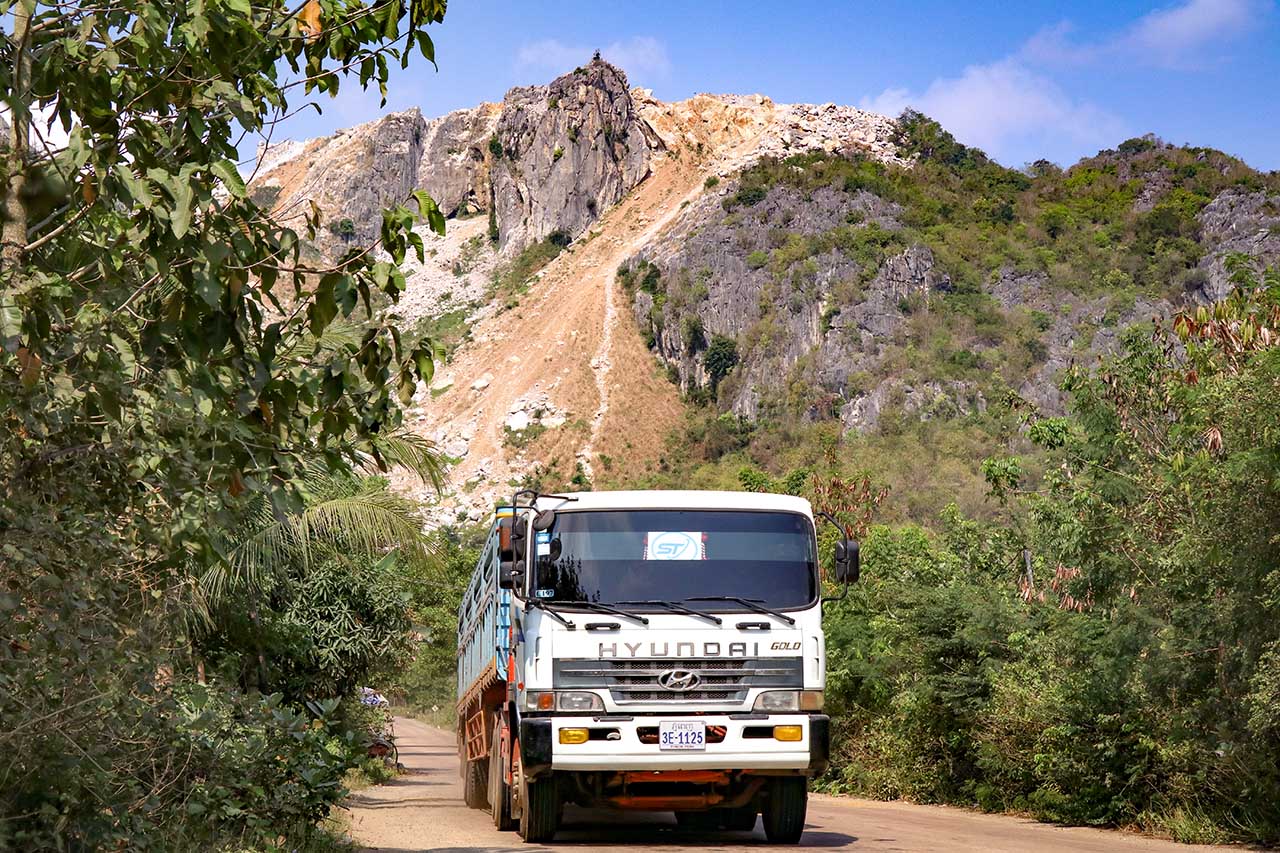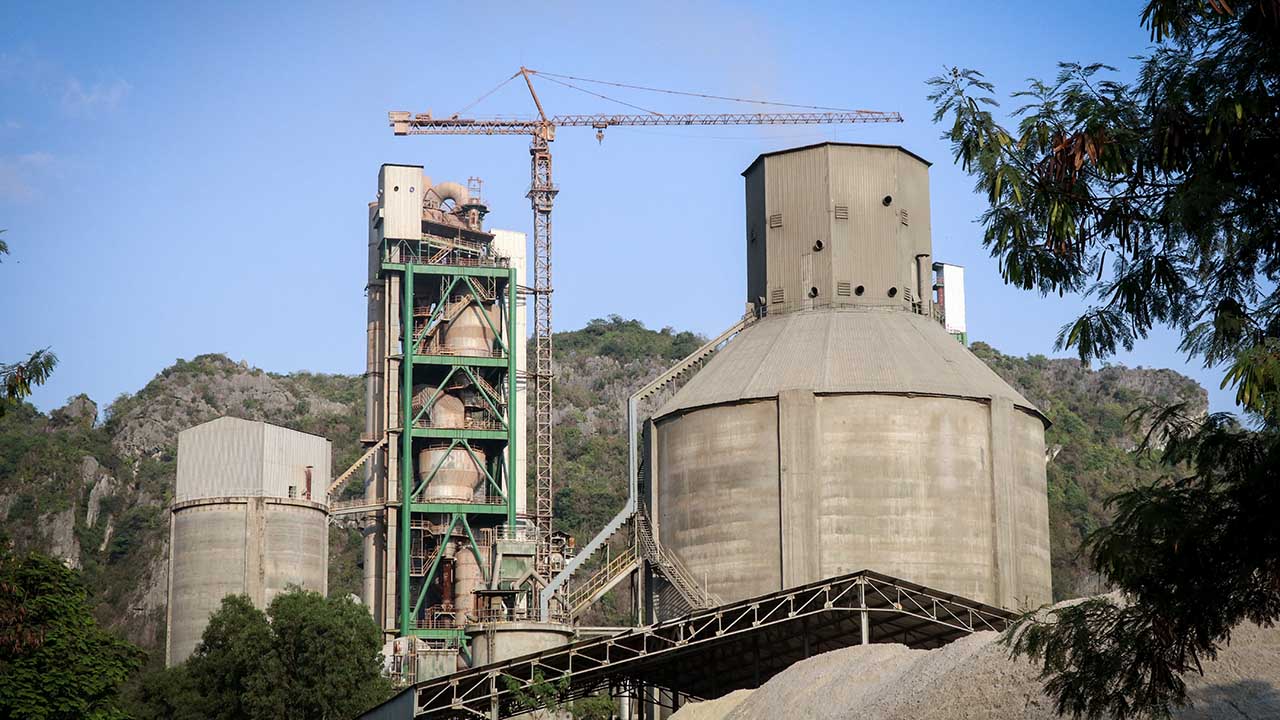
(Khan Sokummono and Nov Povleakhena and produced by Say Mony)
Community Stories
Cement Processing Brings Jobs, Leaves Scars
While the people of Kampot province welcome the economic opportunities that arrived with a cement plant, many worry about the social and environmental changes accompanying development.
Tuk Meas Khang Lech Commune, Kampot Province Until 10 years ago, Totung Mountain, with sheer limestone cliffs rising from the surrounding paddy fields, was a tranquil site that villagers regularly visited to collect wild vegetables.
With their cattle grazing on Totung’s cool lower reaches, some villagers here in southern Cambodia’s Kampot province would undertake small-scale quarrying, breaking off rocks to sell for local construction projects.
| By the numbers | National |
|---|
The community would meet with monks and hold ceremonies at a local pagoda on the mountain’s southeastern flank, which sits near a trail to a sacred cave, the site of Buddhist and animist worship for centuries.
In 2006, however, the quiet pace of rural lives lived amid bucolic scenery changed when Kampot Cement, known locally as K-Cement, obtained a 100-year government concession to quarry the mountain and began construction on a plant.
Now, only the mountain’s eastern slope remains intact. Scars left by the heavy machines used to extract rock mark the summit and western slopes. Chunks of the mountain are crushed into the fine gravel central for cement processing at a vast factory complex to the west of Totung.
The K-Cement operation stands in jarring testimony to the two Cambodias of today – the rural world of traditional farming and the development best seen in Phnom Penh, a bright-lights boomtown that consumes the cement – about 1 million metric tons – that comes from Totung Mountain.
“There were monkeys, pythons, all kind of birds on the mountain,” said Tith Tar, a 54-year-old farmer, adding that the only remaining wildlife is hungry pythons hiding in paddy field streams.
“In the past, I used to collect firewood on the mountain and picked up all kinds of vines” he said. “Nowadays, if you don’t have an employee card, you are not even allowed to get close.”
The company’s blasting, with its noise and flying debris, limits the monks’ meditation and the community’s worship to mornings and evenings. Local people are still talking about a massive rock that just missed hitting the pagoda.

A truck transporting K-Cement passing through the road leading up to Totung Mountain where K-cement factory is located. (Sun Narin | VOA Khmer)
A boon for local economy
Yet despite such environmental loss and hazards, many people view the the arrival of the company – Cambodia’s largest cement producer, 90 percent owned by Thailand’s Siam Cement Group and Khaou Chuly Group, the well-connected local minority owner – as a development that improved the local economy.
Tith Tar, who has one son, said he joined the company as a gardener in 2012, earning about $140 per month, a relatively big paycheck for a rural Cambodian.
“I think it is good that the company is here, and that I can work here and stay home with my family,” he said. Without the job, Tith Tar said that his other job options were leaving home for temporary work in Phnom Penh or in Thailand. If he had taken that route, he would have joined the thousands of rural Cambodians who augment their farm income with cash earned elsewhere.
Tith’s Tar’s wife, Tam Oung, also found work with K-Cement, earning about $100 per month as a cook in the cafeteria the company maintains for approximately 1,200 workers.
Just outside the K-Cement gates are other signs of economic development: restaurants, phone shops, a laundry service, a small market and a remittance service for workers who send money home.
Hieng Hoeun, 48, owns one of those enterprises, a small grocery store that he runs with his wife. It is directly in front of the factory. His daughter operates a food stall.
The family moved from their village in Trapeang Chrinh to Totung village in early 2001, when Hieng Hoeun first learned that K-Cement would start operations near the mountain in 2008.
In his village, Hieng Hoeun farmed, but he and the family wanted more opportunities. “So we bought this plot of land and started a business here,” he said.The family worked hard and prospered as their businesses became a gathering spot for workers, local residents and officials from the ruling Cambodian People’s Party (CPP), the opposition Cambodia National Rescue Party (CNRP) and the royalist FUNCENPEC.
But since Cambodia’s Supreme Court dissolved the opposition CNRP in November as part of the government’s crackdown on dissent, he said the political types “don’t come here to purchase anything from my store anymore.” The cement factory workers are now his mainstay customers, and after a family discussion, Hieng Hoeum said everyone eligible to vote will back the CPP.
“I don’t dare vote to change because everything is good right now,” he said. “I don’t demand anything.”

Kampot Cement Factory is seen at the foothill of Totung Mountain in Kampot’s Tuk Meas Khang Lech commune. (Aun Chhengpor | VOA Khmer)
Villages at a turning point
While the factory’s arrival has been a welcome boon for the local economy and employment, there is nonetheless a clear sense among residents that their communities have reached a turning point.
Across Kampot province, an idyllic coastal region, K-Cement and two other cement companies are breaking down many of the scenic karsts as they feed Phnom Penh’s appetite for tall, modern buildings.
This rapid economic development and unrestrained exploitation of the shrinking natural resources has loosened the Khmer villagers’ ancient connection with the land and is changing their environment forever.
Neout Sokim, 30, said in an interview at his wooden house surrounded by sapodilla trees that he was debating whether to give up farming and become a full-time driver for K-Cement, a job he already does part time.
“I make about the same. Actually, I would make a bit more money being a farmer,” he said, before adding that factory work is more secure, while “farming has no future.”
“It’s not good because people soon will forget about their rice paddies,” he said. “Farming gives me a lot of freedom. Working for a company, you can expect to be scolded almost every day if you don’t perform well.”
Impact-heavy development
Many of the changes playing out across of rural Cambodia, where vast areas of tropical forests have been logged, farmlands seized, rivers dammed and mineral wealth mined by companies connected to the government of the ruling CPP. Activists documenting such projects claim the government has shown little concern for regulating the activities or obtaining compensation for citizens bearing the brunt of the social and environmental impacts.
Locals near Phnom Totung are well aware of the fact that they never had much say or insight in the development of the quarry.
Kim Neoun, deputy chief of the Tuk Meas Khang Lech commune, said villagers were not consulted or offered detailed information about K-Cement. Nor have they been compensated the company.
He added that the biggest local beneficiaries are young men with some education because they’re a good match for K-Cement jobs. The rest of the community bears the burdens such as cement trucks ruining the surfaces of local roads not designed for such heavy loads, flooding, and so much dust that 100 villagers protested in 2014.
During a lunch break at one of the food options outside the gates, Korng Kungkea said that he is happy to be earning $300 per month and to get company-subsidized housing for his family – one 16-square-meter room that costs $25 a month.
“I think it is good to have companies like this closer to our community,” said the 29-year-old. “Some people don’t have skills, but they are smart and work hard so they are hired.”
Kim Neoun acknowledged that while “I do want to protect the mountain … we are developing the country, we need to extract those resources.”
Company-community relations
Keo Muthora, a K-Cement human resources staffer, said the company had established a community relations team that responded to the latter complaint by spending up to $2 million on paved roads to the factory site. He added that another $1 million has been spent on health care and education in the local communities since 2008, while discussions about flooding problems were ongoing.
“Whenever the community requests that we build a road, a sewage system, a bridge or a canal, we consider those requests, but there are limits in terms of what we can do,” he said, adding that “flooding also occurred before the company arrived.”
Villagers and the deputy commune chief, who confirmed that the company had been responsive, said they were hopeful that the flooding could be addressed.
Keo Muthora said local lives had improved because of the factory as its workers could now “afford to buy televisions and new motorbikes… in the past, people were just selling bamboo shoots or collecting firewood.”


ABOVE: The karst and livelihood at the foothill of Totung Mountain in Kampot’s Tuk Meas Khang Lech commune. BELOW: A bulldozer works on the slope of Totung Mountain. (Photos by Khan Sokummono | VOA Khmer)
From unique biodiversity to skyscraper
Environmentalists, however, claim that companies like Kampot Cement have failed to implement a proper assessment of the quarry’s environmental impact on the unique, biodiverse ecosystems of the karsts.
“Despite Siam Cement being a member of the Cement Sustainability Initiative of the World Business Council for Sustainable Development, no appropriate biodiversity inventory has yet been conducted,” said Tony Whitten, former director for Fauna and Flora International Asia-Pacific region, in an August 2015 YouTube video that featured drone footage of Phnom Totung.
“When the hill is quarried these species become extinct,” he said, adding that FFI had in vain asked to see the environmental impact assessment.
A New York Times article in 2017 described efforts by a small group of scientists who are documenting the rapidly disappearing biodiversity of Kampot’s karsts, which are in fact geological remnants of millions-of-years-old coral reefs.
The spiky limestone cliffs jutting out of the paddies are small habitats for highly specialized plants and animals, and serve as “ ‘arks’ of biodiversity that replenish surrounding areas after ecological damage,” the article notes, adding, they “are so complex that, once destroyed, they can never themselves be recreated.”
Keo Muthora insisted that the company had conducted an environmental impact assessment as required by the government, which approved it ahead of the start of operations.
Muong Neoun, the CPP governor of Kampot’s Banteay Meas District, said the assessment had been shared with local officials and discussed with the company before quarrying began. He added that the company’s corporate social responsibility projects in health and education helped the community, though he could not specify how much was spent on it, or how many people benefited.
Muong Neoun brushed off concerns over the rapid environmental changes in his district, saying that any path to economic development necessitates resource exploitation, saying, “The mountains will be gone in 100 or 200 years, but they will be transformed into cement for construction, into skyscrapers – and our community members will definitely benefit from this [process].”
More videos | Development
Not Everyone Benefits from Development
Uneducated, Chiem Sophal doesn’t qualify for a cement company job. Instead, she augments her farming income by breaking rocks by hand.









